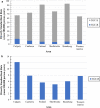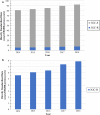Increasing incidence and antimicrobial resistance in Escherichia coli bloodstream infections: a multinational population-based cohort study
- PMID: 34488891
- PMCID: PMC8422618
- DOI: 10.1186/s13756-021-00999-4
Increasing incidence and antimicrobial resistance in Escherichia coli bloodstream infections: a multinational population-based cohort study
Abstract
Background: Escherichia coli is an important pathogen in humans and is the most common cause of bacterial bloodstream infections (BSIs). The objectives of our study were to determine factors associated with E. coli BSI incidence rate and third-generation cephalosporin resistance in a multinational population-based cohort.
Methods: We included all incident E. coli BSIs (2014-2018) from national (Finland) and regional (Australia [Canberra], Sweden [Skaraborg], and Canada [Calgary, Sherbrooke, and western interior]) surveillance. Incidence rates were directly age and sex standardized to the European Union 28-country 2018 population. Multivariable negative binomial and logistic regression models estimated factors significantly associated with E. coli BSI incidence rate and third-generation cephalosporin resistance, respectively. The explanatory variables considered for inclusion in both models were year (2014-2018), region (six areas), age (< 70-years-old and ≥ 70-years-old), and sex (female and male).
Results: We identified 31,889 E. coli BSIs from 40.7 million person-years of surveillance. Overall and third-generation cephalosporin-resistant standardized rates were 87.1 and 6.6 cases/100,000 person-years, respectively, and increased 14.0% and 40.1% over the five-year study. Overall, 7.8% (2483/31889) of E. coli BSIs were third-generation cephalosporin-resistant. Calgary, Canberra, Sherbrooke, and western interior had significantly lower E. coli BSI rates compared to Finland. The significant association between age and E. coli BSI rate varied with sex. Calgary, Canberra, and western interior had significantly greater odds of third-generation cephalosporin-resistant E. coli BSIs compared to Finland. Compared to 2014, the odds of third-generation cephalosporin-resistant E. coli BSIs were significantly increased in 2016, 2017, and 2018. The significant association between age and the odds of having a third-generation cephalosporin-resistant E. coli BSI varied with sex.
Conclusions: Increases in overall and third-generation cephalosporin-resistant standardized E. coli BSI rates were clinically important. Overall, E. coli BSI incidence rates were 40-104% greater than previous investigations from the same study areas. Region, sex, and age are important variables when analyzing E. coli BSI rates and third-generation cephalosporin resistance in E. coli BSIs. Considering E. coli is the most common cause of BSIs, this increasing burden and evolving third-generation cephalosporin resistance will have an important impact on human health, especially in aging populations.
Keywords: Antimicrobial resistance; Bacteremia; Bloodstream infection; Escherichia coli; Incidence rate; Population-based; Third-generation cephalosporins.
© 2021. The Author(s).
Conflict of interest statement
MCM reports a scholarship from the Canadian Institutes of Health Research and funding for a Federal Student Work Experience Program placement from the Government of Canada—Genome Research Development Initiative, both related to her PhD program and outside the submitted work. LV reports being a stock holder of Lumed Inc., outside the submitted work. All other authors declare that they have no competing interests.
Figures



Similar articles
-
Mortality in Escherichia coli bloodstream infections: a multinational population-based cohort study.BMC Infect Dis. 2021 Jun 25;21(1):606. doi: 10.1186/s12879-021-06326-x. BMC Infect Dis. 2021. PMID: 34172003 Free PMC article.
-
A 21-Year Survey of Escherichia coli from Bloodstream Infections (BSI) in a Tertiary Hospital Reveals How Community-Hospital Dynamics of B2 Phylogroup Clones Influence Local BSI Rates.mSphere. 2021 Dec 22;6(6):e0086821. doi: 10.1128/msphere.00868-21. Epub 2021 Dec 22. mSphere. 2021. PMID: 34935444 Free PMC article.
-
Nosocomial bloodstream infections caused by Escherichia coli and Klebsiella pneumoniae resistant to third-generation cephalosporins, Finland, 1999-2013: Trends, patient characteristics and mortality.Infect Dis (Lond). 2016;48(3):229-34. doi: 10.3109/23744235.2015.1109135. Epub 2015 Nov 18. Infect Dis (Lond). 2016. PMID: 26577519
-
Targeted literature review of the burden of extraintestinal pathogenic Escherichia Coli among elderly patients in Asia Pacific regions.J Med Econ. 2023 Jan-Dec;26(1):168-178. doi: 10.1080/13696998.2023.2169447. J Med Econ. 2023. PMID: 36647596 Review.
-
Cephalosporin Resistance in Escherichia coli Isolated from Children with Septicemia in Mainland China from 2007 to 2017: A Systematic Review and Meta-Analysis.Microb Drug Resist. 2020 Oct;26(10):1250-1259. doi: 10.1089/mdr.2018.0368. Epub 2020 Feb 3. Microb Drug Resist. 2020. PMID: 32013730
Cited by
-
Population-Based Incidence and Characteristics of Adult Escherichia coli Bloodstream Infection in Queensland, Australia, From 2000 to 2019.Open Forum Infect Dis. 2023 Feb 10;10(3):ofad071. doi: 10.1093/ofid/ofad071. eCollection 2023 Mar. Open Forum Infect Dis. 2023. PMID: 36968960 Free PMC article.
-
Frequency of antimicrobial-resistant bloodstream infections in 111 hospitals in Thailand, 2022.J Infect. 2024 Oct;89(4):106249. doi: 10.1016/j.jinf.2024.106249. Epub 2024 Aug 22. J Infect. 2024. PMID: 39173918 Free PMC article.
-
Multi-Drug Resistant Bacteria as Aetiological Factors of Infections in a Tertiary Multidisciplinary Hospital in Poland.Antibiotics (Basel). 2021 Oct 10;10(10):1232. doi: 10.3390/antibiotics10101232. Antibiotics (Basel). 2021. PMID: 34680812 Free PMC article.
-
Assessment of Prevalence and Diversity of Antimicrobial Resistant Escherichia coli from Retail Meats in Southern California.Antibiotics (Basel). 2023 Apr 19;12(4):782. doi: 10.3390/antibiotics12040782. Antibiotics (Basel). 2023. PMID: 37107144 Free PMC article.
-
Impact of the COVID-19 pandemic on extended-spectrum β-lactamase producing Escherichia coli in urinary tract and blood stream infections: results from a nationwide surveillance network, Finland, 2018 to 2022.Antimicrob Resist Infect Control. 2024 Jul 6;13(1):72. doi: 10.1186/s13756-024-01427-z. Antimicrob Resist Infect Control. 2024. PMID: 38971782 Free PMC article.
References
Publication types
MeSH terms
Substances
Grants and funding
LinkOut - more resources
Full Text Sources
Medical

